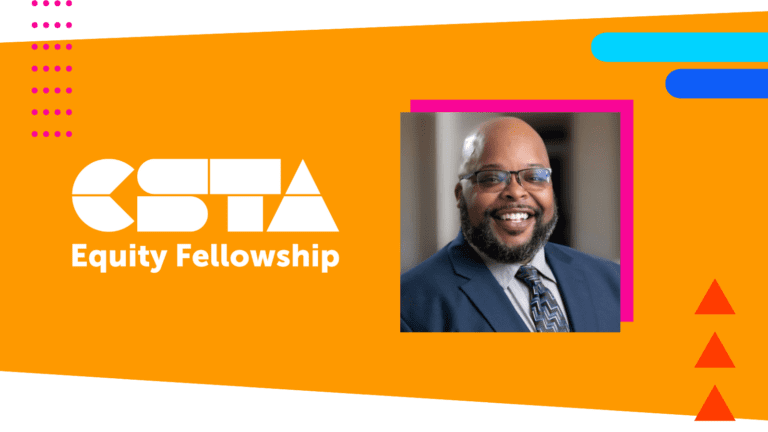Posted by Allen Antoine, Andrea Wilson Vazquez, Michelle Magallanez on Apr 20, 2023

School administrators don’t realize the benefits of having their most dynamic teachers in computing courses because state testing requirements influence them to put their best and brightest in ELA, math, science, and social studies courses.
Full Story
At a recent convening of computer science teachers and leaders from across the country, an educator from Florida made a profound statement that was all too familiar. He lamented that he was allowed to teach two computer science courses but his school administration was not on board with him having a full schedule of computing classes because he is an accomplished teacher and is needed in Algebra I. The implication was clear. Core content areas, like mathematics, outweigh the importance of computing courses. Stop me if you’ve heard this story before.
THE NEED FOR COMPUTING COURSES
Oftentimes, school administrators don’t realize the benefits of having their most dynamic teachers in computing courses because state testing requirements influence them to put their best and brightest in ELA, math, science, and social studies courses. This issue is compounded by the fact that there is a national teacher shortage that has been brought to the spotlight during the pandemic.
BUILDING YOUR CS PROGRAM
Teachers are the key to the equitable expansion of CS education, and yet we know that teachers don’t have space for one more thing.
Addressing teacher capacity in CS K-12 learning pathway development is crucial because teachers are the cornerstone of equitable expansion of CS education. They play a critical role in shaping students’ attitudes, beliefs, and confidence towards CS, and greatly impact the diversity and inclusivity of the future tech workforce. However, we also know that teachers are already overburdened and do not have the necessary training or resources to effectively teach CS. By providing teachers with the tools, support, and professional development needed to build their capacity, we can ensure students learn future-driven skills to address not only the growing gap in the tech workforce, but the sticky social, economic, and environmental issues that weigh on our collective horizon. Investing in teacher capacity building can significantly enhance the potential for expanding CS education and promoting equitable access to future opportunities.
THE SET UP CS FRAMEWORK: ESTABLISHING SYSTEMS TO ENSURE DISTRICT-LEVEL IMPLEMENTATION SUCCESS
You may be wondering, If we need to start by building teacher capacity, why are we talking about a district-level implementation? Our combined years of experience in the classroom and leading at the district level has taught us that for an initiative to succeed at scale, district leaders across the organization need to be engaged and committed to the program’s outcomes. And… With a plethora of computer science (CS) programs available, it can be daunting to determine where to begin. As a result, we aggregated and curated the best CS education resources to simplify for districts the process of implementing an equitable and sustainable K-12 CS pathway.
One framework in particular has informed the direction of the Set Up CS Framework—the CAPE Framework. CAPE Framework, developed by Dr. Carol Fletcher and Dr. Jayce Warner, is a tool for assessing equity within CS education ecosystems, including measuring the capacity for, access to, participation in, and experience of CS education.
But how can districts get started with laying the initial steps for an equitable CS education pathway? What are the planning and implementation steps necessary to build a strong, equity-focused foundation for a new or redesigned CS ed program? That’s where the Set Up CS Framework comes in!
The Set Up CS framework is a 4-step process that maps the steps to a sustainable and scalable district-wide K-12 CS pathway.
- Set Your Vision: Establish your WHY—the vision, goals, and milestones driving your CS education model where you are leading with a justice-centered approach. Adopt tools such as the CSforAll Visions Framework and SCRIPT planning rubric to ensure the CS education ecosystem being developed is framed on an inclusive, deliberate process aligned to the aspirations of your community.
- Examine Context / Establish Systems: Assess the context for state and local policies impacting CS education in your district. Commit to crafting equitable experiences for all students by evaluating the CS education systems that are currently in place at a local, state, and national level. Assess the environment for CS education in your specific state using tools such as the ECEP Landscape Toolkit to reflect on policies that are in place and plan for systematic changes that allow for meaningful participation for diverse student populations.
- Conduct a district-wide gap analysis. What systems need to be in place to ensure long-term success? What policies are in place at the state level to support your work? What Key Performance Indicators (KPIs) need to be defined at the outset to track the data you need to visualize student outcomes? Use the ECEP Landscape Toolkit as a step-by-step guide to help you define and document how to broaden participation in computing in your district.
- Tee-Up Funding: Define short- and long-term funding priorities based on your context and vision. Learn about CS education funding that is already available in your state by reviewing up-to-date policy information by state, as well as working with CSTA chapter leaders to review resources to access ESSER funds and educational technology partnership programs. Explore federal funding options available via the CHIPS and Science Acts, as well as President Biden’s 2023 Budget Advances in Equity that will support Title 1 schools to expand workforce training and career-connected learning. Lock in your proposed CS education budget with your Superintendent and Board.
- Upskill Teachers: Establish a plan for offering ongoing, differentiated professional development in order to build educator capacity and confidence in planning and delivering equity-focused CS learning experiences. Leverage high-quality content resources such as Critically Conscious Computing, and proven PD structures such as coaching, cohort development, blended-learning models, and CSTA’s quality PD indicators.
- Pick Your Pedagogy: Review and select CS curricula across grade levels that balances equity and meaningful content using tools such as the Teacher Accessibility, Equity, and Content (TEC) Rubric for Evaluating Computing Curricula (TEC Rubric). Advocate for embedding computational thinking activities with an equitable lens across various content areas (INFACT from TERC).
JOIN US TO LEARN MORE!
To learn more about the Set Up CS Framework and how it can be used to support CS education implementation in your district, join us for a hands-on workshop at the CSTA Annual Conference July 11-13, 2023. We will unpack each component of the framework with participants to brainstorm how to easily incorporate a curated list of CS ed resources to inform the implementation of an equitable and scalable K-12 CS pathway. Our goal is to help you envision a vertically articulated, personalized implementation plan that aligns to your district’s initiatives to best prepare your students to be the empathetic problem-solvers of the future.
About the Authors

Allen Antoine, M.Ed. is Director of Computer Science Education Strategy for EPIC (Expanding Pathways in Computing) at UT Austin’s Texas Advanced Computing Center (TACC) where he provides leadership in Computer Science education to manage rapidly expanding diversity, equity, and inclusion initiatives and represents EPIC programs at a state and national level. He serves as the Project Director for the Computer Educator Diversity Initiative (CEDI), where he trains educators in equitable teaching practices in computer science courses while preparing them for the unique challenges of teaching computer science with diversity in mind. He also serves as a lead with the Scaling Inclusive Pedagogy (ScIP) project to support the national dissemination of equity-explicit professional development.
Allen has over 15 years of experience in the educational field, working with elementary students to improve their literacy and numeracy skills, teaching 8th-grade mathematics and Algebra I, and developing curriculum for Alief ISD and Rice University. He regularly gives keynote presentations, consults, and leads workshops, covering a wide variety of STEM, School Culture, Equity and Inclusion, Culturally Responsive Teaching, Inquiry-Based Learning, and Computer Science topics. He also is currently the vice president of CSTA Greater Houston Chapter.

Andrea Wilson Vazquez is the Director of Educator Training and School Partnerships with non-profit Code Savvy, a Minnesota-based non-profit working to expand equitable and engaging K-12 computer science education. She is also a teacher and most recently worked as an innovative instructional coach at an alternative high school, partnering with teachers to engage students with unique learning needs in creative problem solving through maker and computer science education. She also previously served as a Maker and Computer Science educator, as well as a Teacher for English Learners. Andrea holds a B.A. in Spanish and Global Studies, and her K-12 teaching license and M.A. in English as a Second Language Education. She is a CSTA CSforELs Teacher Leader and Facilitator, a Co-PI on the Coaching for Equity in Computer Science initiative, and is passionate about the important role of educators in building equitable CS ed learning experiences.

Dr. Michelle Magallanez is the Director of Special Projects, the innovation incubator at AVID Center, a national educational nonprofit with the mission to close the opportunity gap for all students by helping them build the skills they need to be future ready. She is a proud Mexican American with a PhD in French Medieval Literature from NYU, who to this day continues to work on her math phobia. Third grade multiplication tables were a surprise! She is also an award-winning EdTech interaction designer who has created game-based learning experiences for children and adults in a career that included stints at LeapFrog and leading a studio at Allen Interactions where she advised Fortune 500 Companies. Her path to a CS-related career has been windy. Her role at AVID Center allows her to positively impact students under-represented in CS, helping to make their path to a future filled with possibility a bit less scenic than her own. With 20+ years of experience in product and program development, Michelle’s work currently focuses on designing professional learning and curricular resources in partnership with EdTech companies for K-12 content area teachers new to CS and STEM. Her mission is to build resources for the implementation of computational thinking, CS, and STEM problem-solving in content-area classrooms as foundational learning skills for all students.



